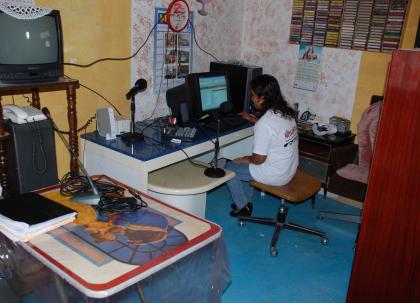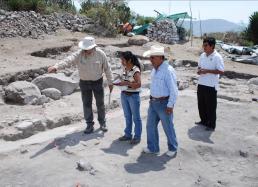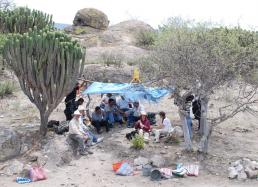3: Roots and Relations
Under Mexican Federal Law, archaeological resources fall under the auspices of the National Institute of Anthropology and History (INAH). As a result, whether you're a Mexican scholar or a foreigner who wishes to undertake an archaeological study in Mexico, you must receive approval from the Council of Archaeology, the assigned branch of INAH that handles fieldwork permissions.
Given the richness of Mexico’s history, it shouldn't be surprising that INAH is a large governmental agency that has responsibilities in many areas, ranging from the preservation of historic buildings, the management of archaeological zones (such as the site of Mitla), the holding of conferences, the publication of research, and the granting of permits to film archaeological sites as part of movie and television projects. I'm also sure that these stated tasks represent just the tip of a far larger set of duties.
At the same time, when directing archaeological research in Mexico—especially in the southern two-thirds of the country where indigenous people have a larger presence—a conversation with local people (whose history you're doing the best job that you can to unearth and write) is basically required. During the 30+ years that I've studied in Mexico, I've seen local/community interest in what we do rise (and that's a good thing).
Perhaps in part, some people are understandably tired of seeing valuable treasures leave their lands. But lately, and more frequently, they see Linda and me as potential vehicles to help them learn about, digest, and possibly help publicize their histories. The latter is not only important both for tourism and whatever economic opportunities it might bring, but also for the growing number of friends and family who are becoming somewhat estranged from their roots living in Los Angeles and points beyond.
The take-away point is, in my opinion, that a foreign archaeologist should never lose sight of the reality that they're a guest, privileged to have the chance to write aspects of someone else’s history based on studies made in lands that are more than likely not your own. At the same time, as archaeologists, you're apt to have a number of hosts, and those diverse hosts may not always see eye-to-eye.
When we began our excavations at the Mitla Fortress in 2009, we'd already lived in Mitla for more than a decade, making many friends and contacts over the years, although we hadn't conducted field research in the town since 1998. Given that last year (2009) was the first in which we excavated in Mitla, there were, expectedly, more questions to answer and more matters at stake.
We were fortunate that the Director of INAH’s Regional office in Oaxaca gave us a suggestion that we first thought was (and that ultimately turned out to be) a very prudent idea. He proposed that we store the collections that we were ultimately to make during our excavations at the Fortress in the locked storage facilities that INAH controls in the now-closed Frissell Museum (in Mitla). We favored this idea because it allowed us to keep the collections actually in Mitla (something that we suspected would be appreciated in town), while also housing them in a way approved by the Institute—in a guarded, dry, and close-at-hand setting.
Before continuing with the retelling of our experience from last year, we have to step farther back in time and provide some detail regarding the Frissell Museum. The roots of the Frissell Museum begin with a hotel and eatery, called La Sorpresa, which is situated just across the street from Mitla’s zócalo. In the 1920s, La Sorpresa was frequented by the anthropologist, Elsie Clews Parsons, who I mentioned in my first dispatch.
In addition to Ms. Parsons, the story goes that luminaries, such famed authors as D.H. Lawrence (Morning in Mexico) and Malcolm Lowry (Under the Volcano) passed time at La Sorpresa. In the 1950s, the inn was sold to a retired American real estate broker, Edwin Robert Frissell, and his wife, Gertrude. The Frissells, working with another man, Howard Leigh, who had a keen anthropological interest, began building a collection of archaeological pieces.
One of my landladies in Mitla recounted how, when she was a child, she would often go out to the fields around Mitla to tend animals, collect plants, visit a shrine, or simply pass time. Once there, she might dig around in the dirt and would occasionally be rewarded by finding a head from a figurine or a stone lance point. When she made such findings, she knew that she could carry the piece to Mr. Leigh at the Frissell, who might offer her a few pesos or give her some candy in exchange for it.
Ultimately, this collection became a museum and the largest assemblage of Zapotec pieces in the world, although few items were of known provenance. I was fortunate to be able to visit the museum various times from the late 1970s through the early 1990s, and its scope was indeed impressive. Yet, in the 1960s, the accumulation practices followed by the Frissells and Leigh became illegal under revised antiquities laws. Changes in ownership and mismanagement followed, culminating in INAH’s decision to close the museum and take control over the collection in 1995.
The Frissell Museum likely never brought large crowds to Mitla. But it was a destination and it probably contributed to Mitla’s reputation as a place to visit in the Valley of Oaxaca. Now closed for repairs for 15 years, citizens from Mitla started to wonder whether the building would ever re-open and what happened to the collection.
Because the prior private owners had not done sufficient repairs, the building fell into ruin and collections had to be moved to secure locations while repair work was undertaken. The length of the closure and doubts about where the collection resided had created a degree of local distrust by the time we arrived last March. Some local authorities wondered whether housing the Fortress collection in the Frissell was a good idea.
Yet in meeting after meeting in 2009, we emphasized two points: A) what we're learning about Mitla’s history and B) how this work and its translation for local citizens could only continue if we, the archaeologists, adhered to the laws and preferences outlined by INAH. By the time we returned to Chicago in late June, the local authorities may not have been comfortable with all the arrangements made, but they grasped why we favored curating our collections in the locked Frissell bodega.
More importantly, a dialogue had begun between INAH officials in Oaxaca and the governing officials of Mitla. By the time we returned in March 2010, the more open channels of communication spurred greater mutual understanding, for which we're grateful to all parties, and thus far, our 2010 field season has been more tranquil (allowing us to focus more directly on the work) than last.
Although the issues that occasionally challenged us last year (and are presently resolved) had little to do with our project directly, we've been told that our willingness to engage the community with our findings has aided us in gaining levels of trust. Whenever a family wanders up to the Fortress, we explain what we're doing and why. Whenever a school class or a neighbor wishes to visit our lab, we welcome them. If local officials want us to speak with the press, we try to accommodate (see above image and Photo #1 below), and if the same officials make time to visit the site, we make sure that they leave with a deeper understanding of what we are doing (see Photo #2 below.)
When reports are written, we provide copies to local authorities as well as Federal and Oaxaca officials. We suspect that many, if not most archaeologists, do the same, and so we neither mean to toot our own horn nor pontificate. Rather, we've learned through the years that a key measure of the significance of what we discover rises in tandem with the level of local interest, engagement, and support.
Archaeologists have recognized the wonders of Mitla for more than a century, but with the exception of the famous Postclassic palaces in the archaeological zone, relatively few Mitleños are familiar with the richness of their own deep history. One of our ongoing objectives is to begin changing that.
Word of the Day: prensa, which means “the press.”
More soon,
Gary




